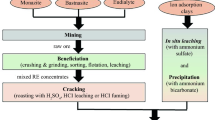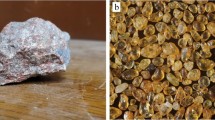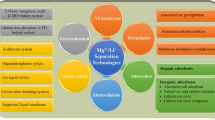Abstract
Fluoride molten-salt electrolytic slag is an important secondary resource for recovery of rare earth elements. In this study, the recovery of rare earths from this source was systemically investigated using borax roasting followed by hydrochloric acid leaching. Increasing the roasting temperature, reaction time and borax dosage promoted the recovery of rare earth elements. The roasting process kinetics was controlled by interfacial chemical reaction, with an activation energy of 159.02 kJ mol−1. The leaching experiments demonstrated that increasing the leaching temperature, time, hydrochloric acid concentration and liquid/solid ratio improved the rare earth recovery. The optimum conditions were identified as roasting the slag at 700°C for 60 min with a borax mass dosage of 38 wt.% and subsequently leaching the resulting rare earth-containing residues in 4 mol L−1 HCl at 60°C at a liquid/solid ratio of 5:1 for 40 min. These conditions gave a rare earth recovery exceeding 97%. This work proposes a novel technical route for efficiently and economically recovering rare earths from this source.







Similar content being viewed by others
References
P. Bakke, K. Pettersen, and H. Westengen, JOM 55, 46 (2003).
T. Du, Chin. J. Nonferrous Met. 6, 15 (1996).
J.S. Rao, H.J. Li, H.S. Xue, and J. Cent, South Univ. Technol. 17, 28 (2010).
H.M. Zhu, Rare Earth Metal Production by Molten Salt Electrolysis (New York: Springer, 2014), pp. 1765–1772.
Z.H. Chen, Adv. Mater. Ind. 6, 31 (2018).
B.N. Deng, G.H. Li, J. Luo, Q. Ye, M.X. Liu, M.J. Rao, Z.W. Peng, and T. Jiang, JOM 70, 2869 (2018).
C.R. Borra, B. Blanpain, Y. Pontikes, B. Koen, and T.V. Gerven, JOM 68, 2958 (2016).
M.D. Liu, Z.X. You, Z.W. Peng, X. Li, and G.H. Li, JOM 68, 567 (2016).
Y. Yang, A. Walton, R. Sheridan, K. Güth, R. Gauß, O. Gutfleisch, M. Buchert, B. Steenari, T.V. Gerven, P.T. Jones, and K. Binnemans, J. Sustain. Metall. 3, 122 (2017).
K. Binnemans, P.T. Jones, B. Blanpain, T.V. Gerven, Y. Yang, A. Walton, and M. Buchert, J. Clean. Prod. 51, 1 (2013).
J.W. Darcy, H.M.D. Bandara, B. Mishra, B. Blanplain, D. Apelian, and M.H. Emmert, JOM 65, 1381 (2013).
D.Y. Chen, Y.H. Ou, L.C. Liu, and G. Xie, Jiangxi Metall. 25, 4 (2005).
D.J. Sun, Chinese Patent No. CN104818390A (2015).
P. Cen, W.Y. Wu, and X. Bian, Metall. Mater. Trans. B 48, 1539 (2017).
Y.K. Huang, T.A. Zhang, Z.H. Dou, J. Liu, and F.F. Tang, Rare Met. 35, 649 (2016).
Y.B. Lu and S.D. Zhu, Chinese Patent No. CN105256156A (2016).
D.Y. Hu, L.C. Li, and R.G. Zhang, Chinese Patent No. CN104843761A (2015).
J. Lin, Q.P. He, and C.X. Li, Chinese Patent No. CN101956078A (2011).
Y. Liang, Y.K. Li, L.Y. Xue, and Z. Yu, J. Clean. Prod. 177, 567 (2018).
Y. Li, H.X. Lei, and X.W. Huang, J. Chin. Soc. Rare Earths 32, 604 (2014).
G.X. Xu, Rare Earths, 2nd ed., Vol. 1 (Beijing: Metallurgical Industry Press Co., Ltd., 2005), p. 367.
H.E. Kissinger, Anal. Chem. 29, 1702 (1957).
P. Budrugeac and E. Segal, J. Therm. Anal. Calorim. 88, 703 (2007).
A. Roine, HSC Chemistry, vers. 9.0. (Pori: Outotec Research Oy, 2016). http://www.outotec.com/products/digital-solutions/hsc-chemistry/. Accessed 25 June 2019.
M.W. Chase, J.L. Curnutt, A.T. Hu, H. Prophet, A.N. Syverud, and L.C. Walker, J. Phys. Chem. Ref. Data 3, 311 (1974).
J.A. Dean, Lange’s Handbook of Chemistry, 2nd ed. (Beijing: China Science Publishing & Media Ltd., 2003), pp. 3.45–3.47.
Acknowledgements
The authors are grateful to the National High Technology Research and Development Program of China (863 Program, Grant No. 2012AA061901) and the National Natural Science Foundation of China (Grant No. 51774155) for financial support.
Author information
Authors and Affiliations
Corresponding authors
Additional information
Publisher's Note
Springer Nature remains neutral with regard to jurisdictional claims in published maps and institutional affiliations.
Rights and permissions
About this article
Cite this article
Yang, Y., Wei, T., Xiao, M. et al. Rare Earth Recovery from Fluoride Molten-Salt Electrolytic Slag by Borax Roasting-Hydrochloric Acid Leaching. JOM 72, 939–945 (2020). https://doi.org/10.1007/s11837-019-03732-0
Received:
Accepted:
Published:
Issue Date:
DOI: https://doi.org/10.1007/s11837-019-03732-0




